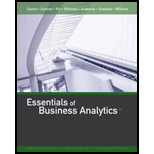
Concept explainers
a.
Find the value of
a.
Answer to Problem 19P
The value of
Explanation of Solution
Calculation:
The binomial experiment with
The
Where, p is the probability of success.
Substitute
Thus, the probability of zero success is 0.3487.
b.
Find the value of
b.
Answer to Problem 19P
The value of
Explanation of Solution
Calculation:
Consider
The value of
Thus, the probability of two successes is 0.1937.
c.
Find the probability of at most two successes.
c.
Answer to Problem 19P
The probability of at most two successes is 0.9298.
Explanation of Solution
Calculation:
Here,
The probability
in the binomial probability formula. That is,
Substitute the other probability values from part (a) and (b),
Thus, the probability of at most two successes is 0.9298.
d.
Find the probability of at least one success.
d.
Answer to Problem 19P
The probability of at least one success is 0.6513.
Explanation of Solution
Calculation:
Here,
Substitute the value from part (a),
Thus, the probability of at least one success is 0.6513.
e.
Find the
e.
Answer to Problem 19P
The expected value of the binomial random variable is 1.
Explanation of Solution
Calculation:
The expected value of a binomial random variable is given by,
Substitute the values
Thus, the expected value of the binomial random variable is 1.
f.
Find the variance and standard deviation.
f.
Answer to Problem 19P
The variance of the binomial random variable is 0.9.
The standard deviation of the binomial random variable is 0.95.
Explanation of Solution
Calculation:
The variance of a binomial random variable is given by,
Substituting the values
The variance of the binomial random variable is 0.9.
The standard deviation of the random variable x is obtained by taking the square root of variance.
Thus, the standard deviation of the binomial random variable is given by,
The standard deviation of the binomial random variable is 0.95.
Want to see more full solutions like this?
Chapter 5 Solutions
Essentials of Business Analytics (MindTap Course List)
- (c) Utilize Fubini's Theorem to demonstrate that E(X)= = (1- F(x))dx.arrow_forward(c) Describe the positive and negative parts of a random variable. How is the integral defined for a general random variable using these components?arrow_forward26. (a) Provide an example where X, X but E(X,) does not converge to E(X).arrow_forward
- (b) Demonstrate that if X and Y are independent, then it follows that E(XY) E(X)E(Y);arrow_forward(d) Under what conditions do we say that a random variable X is integrable, specifically when (i) X is a non-negative random variable and (ii) when X is a general random variable?arrow_forward29. State the Borel-Cantelli Lemmas without proof. What is the primary distinction between Lemma 1 and Lemma 2?arrow_forward
 Trigonometry (MindTap Course List)TrigonometryISBN:9781337278461Author:Ron LarsonPublisher:Cengage Learning
Trigonometry (MindTap Course List)TrigonometryISBN:9781337278461Author:Ron LarsonPublisher:Cengage Learning Elements Of Modern AlgebraAlgebraISBN:9781285463230Author:Gilbert, Linda, JimmiePublisher:Cengage Learning,
Elements Of Modern AlgebraAlgebraISBN:9781285463230Author:Gilbert, Linda, JimmiePublisher:Cengage Learning,

